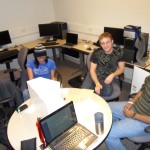Concept
The Fridginator5000 is a system that helps reduce the amount of food that is wasted due to neglect. It tracks the food that a person has in his or her refrigerator and warns the individual when the food is about to go bad, or when the food has gone bad. The user can also use the system to decide on what meals to cook, and The Fridginator5000 will pick a meal that utilizes the most food that is about to spoil.
The Fridginator5000 works by constantly scanning the contents of the refrigerator. When the user puts an item in the refrigerator, The Fridginator5000 scans the item for a UPC code and for an expiration date. If it has a clear sight of the Universal Product Code (UPC) and the expiration date, it will know what item was just placed in the refrigerator and when it expires and will be able to store that information. If it does not get a clear picture of the UPC or expiration date, the user will have to input the information of the item placed in the refrigerator. After that, the refrigerator will keep track of the product by sight (using image processing technology). Produce and other such items that do not have UPCs will have to be input by the user. When an item does eventually expire, The Fridginator5000 warns the user of the expired product, and displays a picture of the item in context, making that particular item easier to find for quick disposal.
Project Responsibilities
- Team facilitation
- Interviewer
- Ethnography
- Contextual Inquiry
- User test facilitation and documentation
- Prototyper (foam core board)
Project Timeline
September 14, 2010 – December 12, 2010
Team Mates
Marie Bautista
Brian Oppenlander
Kamlesh Jain
Background
The concept for Fridginator5000 came out of a long chain of research conducted for the Interaction Design Methods class taught by Shaowen Bardzell at Indiana University in the Fall 2010 semester of the Human Computer Interaction Design program. The Methods course focused on domesticity in 2020, and the first assignment that eventually led to the Fridginator5000 concept was a research assignment focused on studying hoarding.
The hoarding study was conducted as an ethnographic observation in the home of Kamlesh Jain and his roommates. After using a variety of methods to study our data (affinity diagramming and flow, sequence, artifact, cultural, and physical models, concept generation and sketching) we arrived at what we considered to be the core problem we wanted to solve: food waste. Fridginator5000 addresses this problem by keeping track of when a user’s food will expire for them. When a food item is about to expire, it warns the user and suggests meals the user can make to utilize their food in the most efficient way possible.
Methods Used
- Ethnographic Observation
- Affinity Diagram
- Flow Model
- Sequence Model
- Artifact Model
- Cultural Model
- Physical Model
- Sketching
- Brainstorming and Ideation
- Physical Prototyping (foam core)
- Usability Testing



